|
George Eastman's Camera for the
People
by Bob Brooke
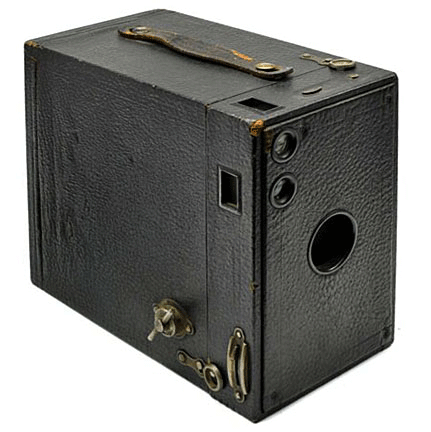 In
1888, George Eastman invented a dry, transparent, flexible photographic
film that came in a roll. He created it for use in his newly designed,
user-friendly Kodak camera. This innovative camera and film combination
enabled the average person to take pictures easily with amazing results. In
1888, George Eastman invented a dry, transparent, flexible photographic
film that came in a roll. He created it for use in his newly designed,
user-friendly Kodak camera. This innovative camera and film combination
enabled the average person to take pictures easily with amazing results.
Eastman purchased his first photographic kit in 1877. It used wet
plates, included a cumbersome darkroom tent and cost him what amounted
to a month’s wages. The wet plates had to be coated with collodion and
then sensitized with nitrates of silver just prior to exposure otherwise
it quickly lost sensitivity. Eastman described the camera as being
“about the size of soapbox” and its tripod as “heavy enough to support a
bungalow.” He felt there had to be a better way.
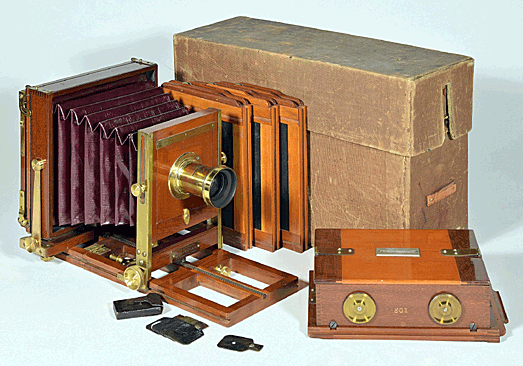
He began exploring the possibilities of dry plate technology which was
then brand new and still quite experimental.
Eastman’s Improvements to Dry Plate
Technology
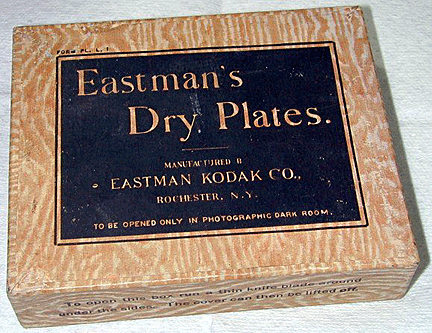 Using
the sink in his mother’s kitchen, Eastman worked on his own formulation
until he came up with one that worked to his satisfaction, both in terms
of ease of production and economy. He was so happy with it, he decided
to begin production and, in the process, invented a mechanical coating
machine to ensure a more precise process than doing it by hand. He
quickly applied for patents for both the machine and his dry plate
formulation in the United States and Britain. Using
the sink in his mother’s kitchen, Eastman worked on his own formulation
until he came up with one that worked to his satisfaction, both in terms
of ease of production and economy. He was so happy with it, he decided
to begin production and, in the process, invented a mechanical coating
machine to ensure a more precise process than doing it by hand. He
quickly applied for patents for both the machine and his dry plate
formulation in the United States and Britain.
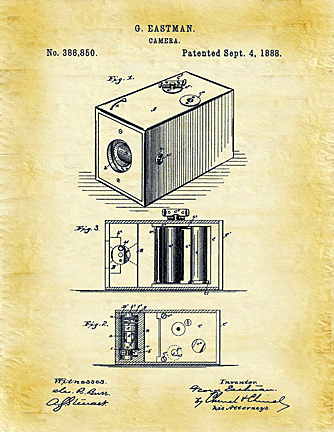 Meanwhile,
he bought the patent rights to 21 inventions related to photographic
cameras issued to David Henderson Houston for $5,750. Houston had
immigrated to America in 1841 from Glasgow, Scotland. He filed his first
patent in 1881 for a camera that used a roll of film—which hadn’t been
invented yet. Houston also licensed patents for folding, panoramic, and
magazine-loaded cameras to Kodak. Meanwhile,
he bought the patent rights to 21 inventions related to photographic
cameras issued to David Henderson Houston for $5,750. Houston had
immigrated to America in 1841 from Glasgow, Scotland. He filed his first
patent in 1881 for a camera that used a roll of film—which hadn’t been
invented yet. Houston also licensed patents for folding, panoramic, and
magazine-loaded cameras to Kodak.
In 1880, using both his own money and that of an investor, Henry Strong,
George Eastman started a business called the Eastman Dry Plate Company,
operating in one room above a music shop in Rochester. His dry plates
quickly gained a reputation for their quality, but already he was
thinking ahead and considering ways to make photography much more
attractive to ordinary people.
Dry plates made things easier, but photography was still a complex and
costly procedure that required some expertise and dedication. Eastman
wanted a system that would not only be easier, but allow for large-scale
production using less expensive materials in order to make the products
more affordable. He began experimenting with coating a light-sensitive
gelatin based emulsion onto a paper backing and, after a lot of trial
and error, eventually came up with a workable design.
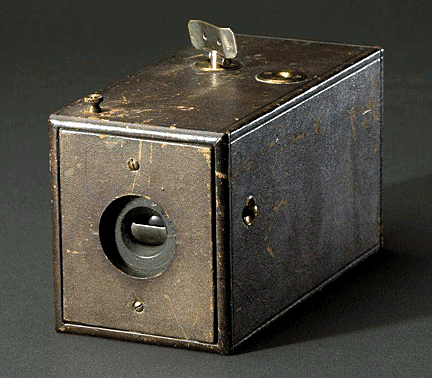 Consequently,
in 1885, he changed his business’ name to the Eastman Dry Plate & Film
Company. At around the same time, George teamed up with a camera maker
called William Walker who had already designed and built a small wooden
box camera that could be handheld and, even better, lent itself to
volume production. The pair then devised a holder that would accommodate
Eastman’s paper negative roll film and fit into Walker’s camera. Consequently,
in 1885, he changed his business’ name to the Eastman Dry Plate & Film
Company. At around the same time, George teamed up with a camera maker
called William Walker who had already designed and built a small wooden
box camera that could be handheld and, even better, lent itself to
volume production. The pair then devised a holder that would accommodate
Eastman’s paper negative roll film and fit into Walker’s camera.
As seems to have happened with every
major development in the history of photography, the roll film camera
met with some resistance despite the obvious conveniences. As far as
established photographers believed the paper negatives were inferior in
quality to glass plates (graininess was a major issue) and their
opinions were influential in what was then a very small community
worldwide.
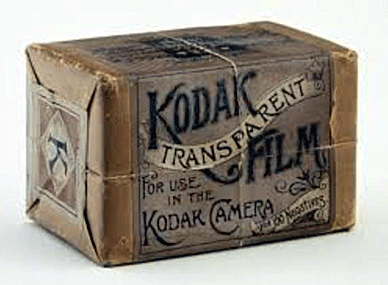 Aware
of the problem, he devised a new triple-layer negative that he called
‘American Film’ and, while it solved the grain issue, it was much more
complicated to develop, which limited its appeal to would-be amateur
photographers. Nevertheless, this didn’t deter George from going ahead
and establishing a production facility to coat long rolls of paper. He
was also working on a more compact roll film camera, but he also knew he
still hadn’t achieved the goal of devising a photography system that
would have the appeal necessary to create a market large enough to
generate the economies of scale needed for a profitable business. But he
was edging closer and closer. Aware
of the problem, he devised a new triple-layer negative that he called
‘American Film’ and, while it solved the grain issue, it was much more
complicated to develop, which limited its appeal to would-be amateur
photographers. Nevertheless, this didn’t deter George from going ahead
and establishing a production facility to coat long rolls of paper. He
was also working on a more compact roll film camera, but he also knew he
still hadn’t achieved the goal of devising a photography system that
would have the appeal necessary to create a market large enough to
generate the economies of scale needed for a profitable business. But he
was edging closer and closer.
Eastman’s Revolutionary Camera
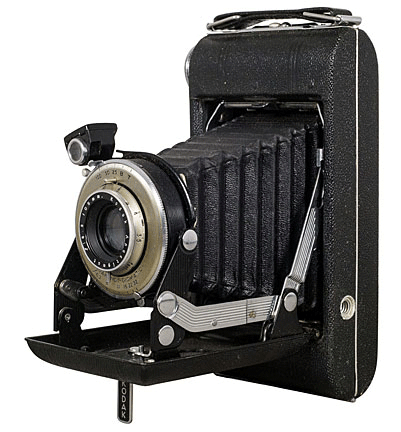 Eastman’s
camera came pre-loaded with his triple-layer “American Film,” enough for
100 exposures, for the purchase price of $25. It could easily be carried
and handheld during its operation. "You press the button, we do the
rest," Eastman promised in the advertising slogan for his revolutionary
invention. Eastman’s
camera came pre-loaded with his triple-layer “American Film,” enough for
100 exposures, for the purchase price of $25. It could easily be carried
and handheld during its operation. "You press the button, we do the
rest," Eastman promised in the advertising slogan for his revolutionary
invention.
After the user exposed the 100 shots on the roll of film, he or she
would return the whole camera to the Kodak company in Rochester, New
York, where workers developed the film, made prints, and inserted a new
roll of film into the camera, before returning the camera to its owner.
The customer then repeated the cycle.
A Camera by Any Other Name Would Not be
a Kodak
George Eastman believed a trademark should be short, unique, and
incapable of being misspelled. He always liked the letter 'K' because it
seemed to be one that was strong and stood out from the rest of the
alphabet.. So he set about trying out a number of combinations of
letters that made words starting and ending with "K."
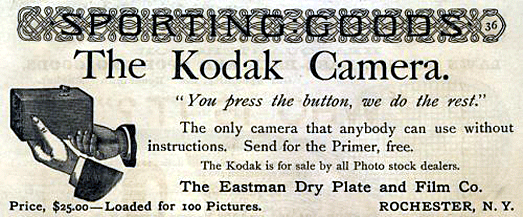
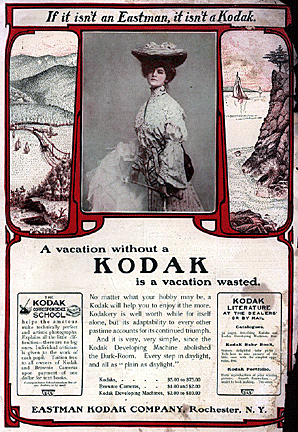 However,
about the time Eastman was doing this, inventor David H. Houston was
living in the town of Nodak, North Dakota, and the two men frequently
communicated. The Kodak/Nodak connection came at about the same time
Eastman bought his first patent from Houston. However,
about the time Eastman was doing this, inventor David H. Houston was
living in the town of Nodak, North Dakota, and the two men frequently
communicated. The Kodak/Nodak connection came at about the same time
Eastman bought his first patent from Houston.
Eastman’s camera gave birth to snapshot photography and for decades it
would be synonymous with the name Kodak.
The most enduring legacy of George
Eastman’s remarkable life’s work was the popularizing of photography,
making the medium available to people who didn’t consider themselves
photographers, but who nevertheless still wanted to record the important
events and occasions that happened throughout their lives. The “Kodak
Moments,” coined in advertising, came to symbolize a moment in time that
was something special.
<
Back
to More Back in Time
Next Article > |
